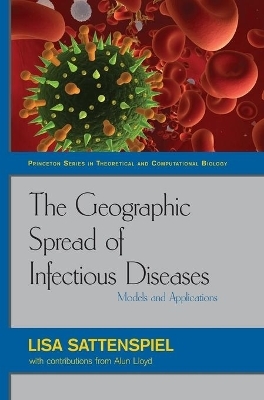
The Geographic Spread of Infectious Diseases
Princeton University Press (Verlag)
978-0-691-12132-1 (ISBN)
The 1918-19 influenza epidemic killed more than fifty million people worldwide. The SARS epidemic of 2002-3, by comparison, killed fewer than a thousand. The success in containing the spread of SARS was due largely to the rapid global response of public health authorities, which was aided by insights resulting from mathematical models. Models enabled authorities to better understand how the disease spread and to assess the relative effectiveness of different control strategies. In this book, Lisa Sattenspiel and Alun Lloyd provide a comprehensive introduction to mathematical models in epidemiology and show how they can be used to predict and control the geographic spread of major infectious diseases. Key concepts in infectious disease modeling are explained, readers are guided from simple mathematical models to more complex ones, and the strengths and weaknesses of these models are explored. The book highlights the breadth of techniques available to modelers today, such as population-based and individual-based models, and covers specific applications as well.
Sattenspiel and Lloyd examine the powerful mathematical models that health authorities have developed to understand the spatial distribution and geographic spread of influenza, measles, foot-and-mouth disease, and SARS. Analytic methods geographers use to study human infectious diseases and the dynamics of epidemics are also discussed. A must-read for students, researchers, and practitioners, no other book provides such an accessible introduction to this exciting and fast-evolving field.
Lisa Sattenspiel is professor of anthropology at the University of Missouri. Alun Lloyd is associate professor of mathematics at North Carolina State University.
Preface ix Chapter 1. Introduction 1 1.1 Mathematical Models and the Geographic Spread of Epidemics 5 1.2 Structure of this Book 11 Chapter 2. The Art of Epidemic Modeling: Concepts and Basic Structures 12 2.1 Essential Biological and Epidemiological Concepts 12 2.2 The Cornerstone of Many Epidemic Models | the SIR Model 16 2.3 Demography and Epidemic Models 23 2.4 More Complex Models 25 2.5 The Basic Reproductive Number Revisited 53 Chapter 3. Modeling the Geographic Spread of Inuenza Epidemics 58 3.1 A Brief Overview of the Biology of Inuenza 58 3.2 Population-based Inuenza Models 61 3.3 Individual-based Inuenza Models 77 3.4 So What Kind of Model Should One Use to Study Inuenza Transmission? 84 Chapter 4. Modeling Geographic Spread I: Population-based Approaches 86 4.1 Spatial Structure and Disease Transmission: Basic Themes 86 4.2 Spatial Modeling Frameworks 89 4.3 Metapopulation Models 90 4.4 Spatially Continuous Models 102 Chapter 5. Spatial Heterogeneity and Endemicity: The Case of Measles 117 5.1 The Persistence and Long-term Cycling of Measles 122 5.2 Spatial Heterogeneity, Synchrony, and the Spatial Spread of Measles 125 Chapter 6. Modeling Geographic Spread II: Individual-based Approaches 134 6.1 Historical Underpinnings of the Use of Networks in Epidemiology 137 6.2 The Nature of Networks 140 6.3 The Language of Network Analysis 142 6.4 Major Classes of Networks 150 6.5 The Inuence of Networks on the Dynamics of Epidemic Spread 159 6.6 Theoretical Analysis of Network Models 162 6.7 The Basic Reproductive Number in Network Models 168 6.8 Infection Control on Networks 171 6.9 Why Aren't There More Applications of Network Models for Spatial Spread? 173 Chapter 7. Spatial Models and the Control of Foot-and-Mouth Disease 176 7.1 Modeling the Geographic Spread of FMD 180 7.2 The Official Response to the Epidemic and Its Aftermath 185 Chapter 8. Maps, Projections, and GIS: Geographers' Approaches 191 8.1 Mapping Methods 191 8.2 Identifying Patterns of Disease Di_usion 195 8.3 Epidemic Projections 204 8.4 Detection of Disease Clustering 208 8.5 New and Potential Directions 211 Chapter 9. Revisiting SARS and Looking to the Future 215 9.1 Did Mathematical Modeling Help to Stop the 2003 SARS Epidemic? 215 9.2 Modeling the Geographic Spread of Past, Present, and Future Infectious Disease Epidemics: Lessons and Advice 223 Bibliography 237 Index 279
| Erscheint lt. Verlag | 26.7.2009 |
|---|---|
| Reihe/Serie | Princeton Series in Theoretical and Computational Biology |
| Zusatzinfo | 44 line illus. 1 table. |
| Verlagsort | New Jersey |
| Sprache | englisch |
| Maße | 152 x 235 mm |
| Gewicht | 539 g |
| Themenwelt | Mathematik / Informatik ► Mathematik ► Angewandte Mathematik |
| Studium ► Querschnittsbereiche ► Infektiologie / Immunologie | |
| ISBN-10 | 0-691-12132-X / 069112132X |
| ISBN-13 | 978-0-691-12132-1 / 9780691121321 |
| Zustand | Neuware |
| Informationen gemäß Produktsicherheitsverordnung (GPSR) | |
| Haben Sie eine Frage zum Produkt? |
aus dem Bereich


